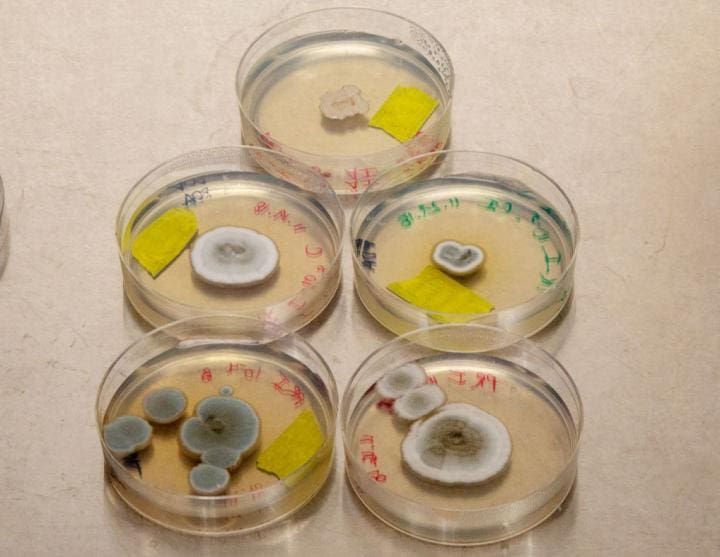
Different fungal species isolated from native and disturbed soils within Florida International University’s Miami campus and Everglades National Park. (Photo: Mary Tiedeman)
CROPS just can’t do without phosphorus.
Globally, more than 45 million tons of phosphorus fertiliser are expected to be used in 2019.
But only a fraction of the added phosphorus will end up being available to crops.
In south Florida, for example, “it is thought that less than twenty percent of phosphorus applied as fertiliser is taken up by plants before it becomes unavailable,” says Mary Tiedeman, a researcher at Florida International University.
The impact is two-fold: financial and environmental.
“Fertiliser costs are significant for farmers in south Florida,” Tiedeman said.
“And phosphorus rock, the most widely used source of phosphorus fertiliser, is in low supply across the globe. It is thought that phosphorus rock resources will only be available for the next 50 to 200 years.”
Fungi role in phosphorus availability
Tiedeman is exploring whether a rarely-studied process involving soil fungi could contribute to low phosphorus availability to plants in south Florida.
This research could also help unravel how land use influences fungal communities in soil. It may also help us better understand vital soil-phosphorus dynamics.
“In general, fungi play a tremendous role in cycling phosphorus within soils,” Tiedeman said.
“They can release phosphorus from mineral (rock) and organic (decaying matter) sources. From there, plants take up the released phosphorus.”
But under specific environmental conditions, like those found in south Florida soils, fungi may be contributing to the problem of phosphorus unavailability.
Some fungi are capable of making minerals out of elements dissolved in soil water. This process is called “bioprecipitation”.
Tiedeman wonders if fungi can take dissolved (plant-available) phosphorus and convert it to less available mineral forms.
The soils of south Florida add another layer to the puzzle.
“Agricultural soils in south Florida are quite unique,” Tiedeman said.
“They were created by pulverizing limestone bedrock to create rocky calcareous soil.”
Limestone is made of calcium carbonate. When phosphorus is in the presence of carbonates in solution, it forms a microscopic layer on the surface of the limestone. Even without fungi, phosphorus availability is quickly suppressed in south Florida’s soils.
“Over time, this coating can become a ‘seed’ for more stable, less available forms of phosphorus.” Tiedeman said.
Phosphorus cycle
Without freed-up phosphorus, crops can’t grow successfully. So many farmers in south Florida have kept adding phosphorus to soils.
In a continuing cycle, most of this phosphorus becomes unavailable to plants.
Over time, large amounts of unavailable phosphorus have collected in these soils.
“Some agricultural soils in the area have 100-200 times more phosphorus than what was naturally present. Along with high concentrations of P, the types of P compounds present in these soils are perplexing.
“Recent studies have documented the presence of apatite – a phosphorus crystal that generally requires intense heat and pressure in order to form. One hypothesis, which is driving Tiedeman’s research, is that microorganisms in the soil are creating stable phosphorus minerals.”
Laboratory tests
To investigate whether fungi are able to create phosphorus minerals, Tiedeman is bringing the fungi into the lab.
This allows her to explore several questions: How do local soil fungi respond to doses of available phosphorus while living in limestone soils? Do fungi contribute to the crystallisation of phosphorus?
“We plan to analyse fungal samples and any bi-products of their growth using a scanning electron microscope,” Tiedeman said.
“That would allow us to actually look for crystal forms of phosphorus. It may also help us better understand how fungi get crystals to form.”
The study’s findings aren’t limited to south Florida, though. An estimated 10 per cent of all arable soils are high in carbonates that behave like limestone’s calcium carbonate.
“Investigating south Florida’s limestone soils may have implications beyond a regional scale,” Tiedeman said.
“Identifying all processes involved in phosphorus unavailability in calcareous soils will be useful in developing strategies to improve fertiliser use efficiency. This could be of great benefit to producers and the environment.”
Source: American Society of Agronomy
https://www.eurekalert.org/pub_releases/2019-03/asoa-anf032119.php

HAVE YOUR SAY